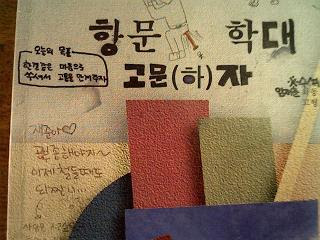On the other hand, in Korea, you are provided all of your textbooks (free of charge, if I remember correctly), which are paperbacks and quite small -- the textbooks are smaller not because Koreans learn less in school, but because they have many more subjects, often around 15 or so. I've also found that the North American schools pick and choose the units being covered from the textbooks, while the Koreans tend to cover everything that is in the textbook. The Korean textbooks are often very dense and to-the-point as well.
Anyway, you own these books, and you are free to take notes, or write on your textbooks as you please. What do the Korean 급식s do when you suddenly get a bunch of free books that you don't really care about?
Well, you set out to create an internet legend. The practice of "교과서 튜닝" or "textbook tuning" has been popular for several decades, and it is still going strong. In Korean, "튜닝" or "tuning" almost exclusively means "doing some modifications to improve the object." It is often used in the context of cars, but in this case, it is applied to textbooks.
Usually, your goal is to modify a page (or the cover) of the textbook to make it funnier. If you do a good job, your post achieves the fifteen minutes of internet fame. Here are some examples of what the Korean students do in their free time.
 |
| Left is original, right is modified. She looks more stylish, for sure! |
 |
| Left is original (wearing the Korean traditional clothing called 한복), and right is modified. |
You can be as creative as you want with these textbooks, and almost everyone does it at some point. Ask your Korean friends about their experiences with 교과서 튜닝, and you'll hear some amusing answers!





0 comments:
Post a Comment